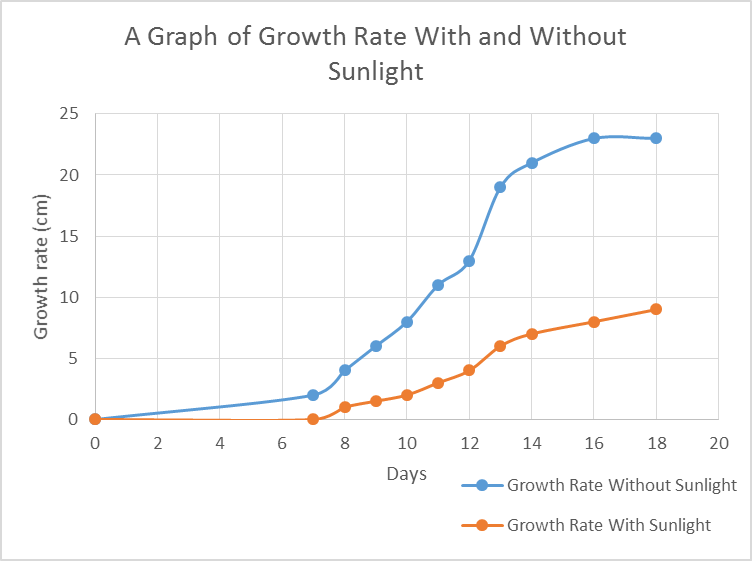Introduction
Germination, which is responsible for the propagation of plants, requires moisture, warmth, and oxygen to liberate stored energy from the cotyledon. Thereafter, light is needed to help shoots from the germinated seeds to manufacture food for plant growth via photosynthesis. However, it is observed that seeds of certain plants fail to germinate even in the presence of water, moisture, and oxygen (Flores, González-Salvatierra, & Jurado, 2016). This observation indicates that light, a fourth factor, is needed for germination.
Consequently, plants can be grouped into three groups based on their need for light for germination. Positively photoelastic plants need light for germination while negatively photoelastic plants require darkness for the same process (Flores et al., 2016). In contrast, neutral photoelastic plants can germinate with or without light. Seed size is also thought to influence seed germination in the presence and absence of light. For example, small seeds are reported to be positively photoelastic, whereas large seeds are negatively photoelastic (Flores et al., 2016). Knowledge of the effects of light on germination is important in the proliferation of wild species to ensure their survival as well as to provide different plant species with optimal conditions to boost their productivity.
Based on the impact of seed size on the light requirement for germination, it was hypothesized that pea seeds would germinate well in the absence of sunlight than in the presence of sunlight. The purpose of this experiment was to use the scientific method to investigate the effect of light on germination and growth of seeds. Ten pea seeds and ten pots were provided. The pots were filled with potting soil after which one seed was placed into each of the pots and pushed 1 cm into the soil using a finger. Five pots for the negative controls (not exposed to sunlight) were labeled 1, 2, 3, 4, and 5. A similar labeling approach was used for the treatment groups (peas grown in the presence of sunlight). All pots were watered with the same quantity of water every other day from day 0 to the last day of the experiment. The seeds were observed every day for germination. The length of the plants was measured (in cm) and recorded every day using a metric ruler.
Data
The pea seeds germinated faster in the absence of light than in the presence of sunlight as shown by the absence of germinated seeds by day 7 in pots kept in sunlight. Also, a faster growth rate was realized in the absence of sunlight than in the presence of sunlight as indicated by the height of the plants by the end of the experiment. Plants grown without sunlight attained a mean height of 23 cm while plants growing in sunlight reached 9 cm (Table 1). However, the plants growing in the absence of sunlight had thin stems and small leaves, whereas those growing in the sunlight had thick stems and large, broad leaves. The data in Table 1 were plotted as indicated in Figure 1. Figure 1 shows a significant difference in the growth rate of plants growing in the presence and absence of sunlight.
Table 1: The growth rate of peas with and without sunlight.

Analysis
The findings of the experiment supported the hypothesis that pea seeds would germinate well in the absence of sunlight than in the presence of sunlight. This observation can be attributed to the size of pea seeds. Simlat et al. (2016) reported that small-seeded plants germinated only when sunlight was available to evade growing deep in the soil. This adaptation prevents the plant from exhausting its food reserves in the cotyledons before accessing light for photosynthesis. Factors such as the moisture content of soil, color, and size of soil particles are known to interfere with the penetration of light through the soil (Motsa, Slabbert, Van Averbeke, & Morey, 2015). Consequently, beneficial light rarely penetrates more than half a centimeter through the soil. In this experiment, variations such as seed depth, soil particle size, moisture content, and soil type were controlled by using the same type of soil, planting all seeds at the same depth, and watering all plants with similar quantities of water at the same time.
It was also noted that plants growing in the sunlight had thick stems and large, broad leaves than those grown without sunlight. This observation could be because they were able to photosynthesize more effectively than those growing in the shade. Photosynthesis is the process through which plants use light energy to manufacture sugars from water and carbon dioxide. Chlorophyll in the leaves of plant traps light of various wavelengths from the sun for photosynthesis. Simlat et al. (2016) report that plants respond differently to the various components of light. For example, blue light promotes the development of leaves and roots and influences the number and rhythm of stomata. Conversely, red light augments the length of stems and roots but does not favor the synthesis of chlorophylls and carotenoids (Simlat et al., 2016). It was likely that growing peas in sunlight promoted the absorption of red light hence the observed rate of growth as indicated in Figure 1.
Conclusion
The findings of this experiment led to the conclusion that light did not influence the germination of pea seeds. However, the light was crucial for the healthy development of pea plants. Therefore, peas should be exposed to light to thrive.
References
Flores, J., González-Salvatierra, C., & Jurado, E. (2016). Effect of light on seed germination and seedling shape of succulent species from Mexico. Journal of Plant Ecology, 9(2), 174-179.
Motsa, M. M., Slabbert, M. M., Van Averbeke, W., & Morey, L. (2015). Effect of light and temperature on seed germination of selected African leafy vegetables. South African Journal of Botany, 99, 29-35.
Simlat, M., Ślęzak, P., Moś, M., Warchoł, M., Skrzypek, E., & Ptak, A. (2016). The effect of light quality on seed germination, seedling growth and selected biochemical properties of Stevia rebaudiana Bertoni. Scientia Horticulturae, 211, 295-304.